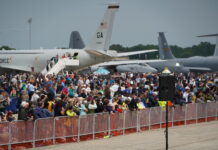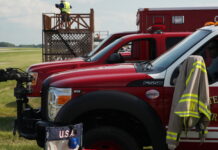On August 28, 1988, 47 spectators were killed at an air show on a U.S. air force base in Ramstein, Germany when three jets from the Frecce Tricolori collided and one crashed into the spectator area. The death toll was unprecedented. The video footage was horrifying. And the media reaction in North America was immediate, highly critical and lasted more than a month.
On July 27 of this year, 83 spectators were killed at an air show in Lviv, Ukraine when a single jet crashed into the show’s viewing area. The death toll was significantly worse than Ramstein. The video footage was, once again, horrifying. But the media reaction in North America was light and short-lived.
Why the difference?
The single most significant reason for the light coverage was the rescue of nine coal miners from a collapsed mine in western Pennsylvania on the same day as the accident in Lviv. Less than one day after the Sukhoi 27 crashed in the Ukraine, the United States was celebrating the unlikely rescue of nine desperate men through a 240-foot deep shaft dug during the preceding three days by a determined band of rescuers. This “good news” story effectively pushed the air show accident off of the front page in most markets.
There were also few North American connections to the story. There were not U.S. or Canadian citizens involved in the accident. The accident occurred in the Ukraine on a Ukrainian air force base as opposed to the 1988 accident which killed six Americans and injured another 41 on a U.S. air force base.
The pop psychologists among us might also suggest that a country and media corps still grieving the loss of 2,900 of its citizens in a despicable terrorist attack less than a year before were a bit less sensitive to the deaths of nearly 100 Ukrainians 8,000 miles from North America.
But we shouldn’t miss some of the more pertinent implications of the media’s light coverage of the tragedy.
The environment in which North American air shows are held has fundamentally changed since 1988. Despite immediate and ongoing efforts by ICAS and the FAA to explain why accidents like the one that occurred in Ramstein were not likely to happen in North America, in August of 1988, news reports openly speculated about future bans on U.S. and Canadian air shows. The air show community was under siege for several weeks.
This year, within several hours of the accident in the Ukraine, ICAS had written and broadly distributed a clear explanation of the differences between North American and European air show regulations. By 2:00 p.m. on the day of the accident, ICAS members had a summary of this explanation in their hands and many of them were using that information to frame their comments to local media inquiring about the potential impact that the accident might have on their local shows.
Perhaps more important, there were few inquiries to which our industry was forced to respond. No indignant editorials. No senseless lashing out by elected officials. No fuming activists using the tragedy in the Ukraine as a tool to work their own anti-air show agenda. In 1988, ICAS responded to several hundred media inquiries. This year, we received just three and all three began with an invitation to explain why such an accident could not occur in North America.
Consider this a return on the investment that our entire industry has made in air show safety over the last decade.
North American air show spectators were at no more risk in 1988 than they are today, but the Ramstein accident came at a time when there were a dozen air show fatalities every year. You could hardly blame the journalist who saw the fireball in Ramstein and the fireballs on domestic television news and felt compelled to ask, “Why doesn’t somebody do something to stop this?”
Today, air show accidents are down nearly 70 percent when compared to the late 1980s. Even if they’re not familiar with the details, journalists intuitively know that things are different here. We can explain the ACE program, set-back distances and the prohibition on aerobatic maneuvers that direct the energy of aircraft toward the crowd, but it’s only to provide those journalists with facts to support what they already know is true.
Air show safety IS different here. Air show professionals and North American regulatory authorities have worked hard over many years to reduce obvious threats to pilot and public safety. That hard work has not eliminated all risk, but the entire North American air show community should knows that it’s having an impact beyond the reduction in accidents. It’s fundamentally changing the perception of our industry by the general public.








